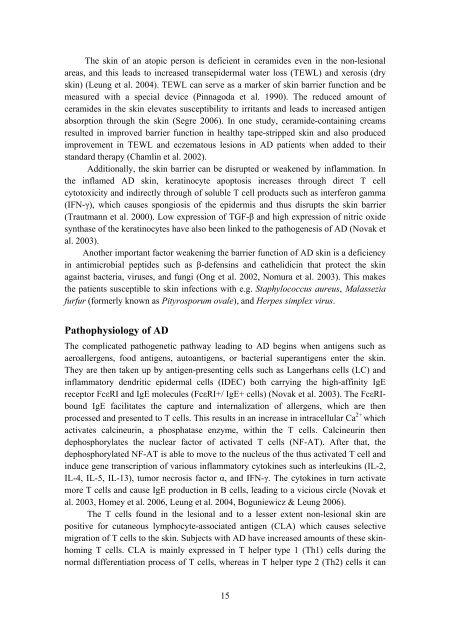Topical tacrolimus in atopic dermatitis: Effects of ... - Helda - Helsinki.fi
Topical tacrolimus in atopic dermatitis: Effects of ... - Helda - Helsinki.fi
Topical tacrolimus in atopic dermatitis: Effects of ... - Helda - Helsinki.fi
Create successful ePaper yourself
Turn your PDF publications into a flip-book with our unique Google optimized e-Paper software.
The sk<strong>in</strong> <strong>of</strong> an <strong>atopic</strong> person is de<strong>fi</strong>cient <strong>in</strong> ceramides even <strong>in</strong> the non-lesional<br />
areas, and this leads to <strong>in</strong>creased transepidermal water loss (TEWL) and xerosis (dry<br />
sk<strong>in</strong>) (Leung et al. 2004). TEWL can serve as a marker <strong>of</strong> sk<strong>in</strong> barrier function and be<br />
measured with a special device (P<strong>in</strong>nagoda et al. 1990). The reduced amount <strong>of</strong><br />
ceramides <strong>in</strong> the sk<strong>in</strong> elevates susceptibility to irritants and leads to <strong>in</strong>creased antigen<br />
absorption through the sk<strong>in</strong> (Segre 2006). In one study, ceramide-conta<strong>in</strong><strong>in</strong>g creams<br />
resulted <strong>in</strong> improved barrier function <strong>in</strong> healthy tape-stripped sk<strong>in</strong> and also produced<br />
improvement <strong>in</strong> TEWL and eczematous lesions <strong>in</strong> AD patients when added to their<br />
standard therapy (Chaml<strong>in</strong> et al. 2002).<br />
Additionally, the sk<strong>in</strong> barrier can be disrupted or weakened by <strong>in</strong>flammation. In<br />
the <strong>in</strong>flamed AD sk<strong>in</strong>, kerat<strong>in</strong>ocyte apoptosis <strong>in</strong>creases through direct T cell<br />
cytotoxicity and <strong>in</strong>directly through <strong>of</strong> soluble T cell products such as <strong>in</strong>terferon gamma<br />
(IFN-�), which causes spongiosis <strong>of</strong> the epidermis and thus disrupts the sk<strong>in</strong> barrier<br />
(Trautmann et al. 2000). Low expression <strong>of</strong> TGF-� and high expression <strong>of</strong> nitric oxide<br />
synthase <strong>of</strong> the kerat<strong>in</strong>ocytes have also been l<strong>in</strong>ked to the pathogenesis <strong>of</strong> AD (Novak et<br />
al. 2003).<br />
Another important factor weaken<strong>in</strong>g the barrier function <strong>of</strong> AD sk<strong>in</strong> is a de<strong>fi</strong>ciency<br />
<strong>in</strong> antimicrobial peptides such as �-defens<strong>in</strong>s and cathelidic<strong>in</strong> that protect the sk<strong>in</strong><br />
aga<strong>in</strong>st bacteria, viruses, and fungi (Ong et al. 2002, Nomura et al. 2003). This makes<br />
the patients susceptible to sk<strong>in</strong> <strong>in</strong>fections with e.g. Staphylococcus aureus, Malassezia<br />
furfur (formerly known as Pityrosporum ovale), and Herpes simplex virus.<br />
Pathophysiology <strong>of</strong> AD<br />
The complicated pathogenetic pathway lead<strong>in</strong>g to AD beg<strong>in</strong>s when antigens such as<br />
aeroallergens, food antigens, autoantigens, or bacterial superantigens enter the sk<strong>in</strong>.<br />
They are then taken up by antigen-present<strong>in</strong>g cells such as Langerhans cells (LC) and<br />
<strong>in</strong>flammatory dendritic epidermal cells (IDEC) both carry<strong>in</strong>g the high-aff<strong>in</strong>ity IgE<br />
receptor Fc�RI and IgE molecules (Fc�RI+/ IgE+ cells) (Novak et al. 2003). The Fc�RIbound<br />
IgE facilitates the capture and <strong>in</strong>ternalization <strong>of</strong> allergens, which are then<br />
processed and presented to T cells. This results <strong>in</strong> an <strong>in</strong>crease <strong>in</strong> <strong>in</strong>tracellular Ca 2+ which<br />
activates calc<strong>in</strong>eur<strong>in</strong>, a phosphatase enzyme, with<strong>in</strong> the T cells. Calc<strong>in</strong>eur<strong>in</strong> then<br />
dephosphorylates the nuclear factor <strong>of</strong> activated T cells (NF-AT). After that, the<br />
dephosphorylated NF-AT is able to move to the nucleus <strong>of</strong> the thus activated T cell and<br />
<strong>in</strong>duce gene transcription <strong>of</strong> various <strong>in</strong>flammatory cytok<strong>in</strong>es such as <strong>in</strong>terleuk<strong>in</strong>s (IL-2,<br />
IL-4, IL-5, IL-13), tumor necrosis factor �, and IFN-�. The cytok<strong>in</strong>es <strong>in</strong> turn activate<br />
more T cells and cause IgE production <strong>in</strong> B cells, lead<strong>in</strong>g to a vicious circle (Novak et<br />
al. 2003, Homey et al. 2006, Leung et al. 2004, Boguniewicz & Leung 2006).<br />
The T cells found <strong>in</strong> the lesional and to a lesser extent non-lesional sk<strong>in</strong> are<br />
positive for cutaneous lymphocyte-associated antigen (CLA) which causes selective<br />
migration <strong>of</strong> T cells to the sk<strong>in</strong>. Subjects with AD have <strong>in</strong>creased amounts <strong>of</strong> these sk<strong>in</strong>hom<strong>in</strong>g<br />
T cells. CLA is ma<strong>in</strong>ly expressed <strong>in</strong> T helper type 1 (Th1) cells dur<strong>in</strong>g the<br />
normal differentiation process <strong>of</strong> T cells, whereas <strong>in</strong> T helper type 2 (Th2) cells it can<br />
15

















